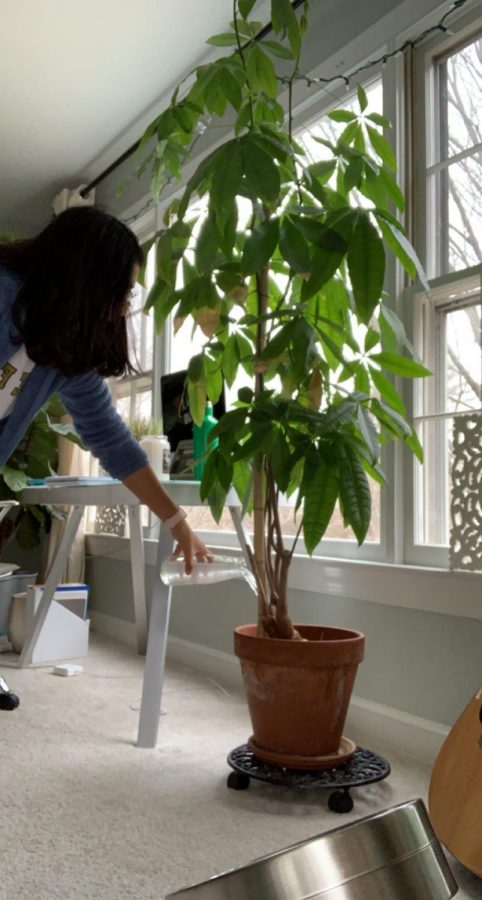Houseplants serve as therapy, hobby, decor
Senior Zara Chavoshi waters her Guiana chestnut tree on Jan. 5.
Having plants in your house comes with several advantages. They purify the air, they can be therapeutic and they are aesthetically pleasing. However, some plants are more fragile and difficult to care for than others, making it difficult to pick the best plants for your house.
The American Horticultural Therapy Association (AHTA) is based on the idea that gardening and surrounding yourself with plants is proven to boost moods and acts as therapy for people. According to the AHTA, “Horticultural therapy helps improve memory, cognitive abilities, task initiation, language skills, and socialization. In physical rehabilitation, horticultural therapy can help strengthen muscles and improve coordination, balance, and endurance.”
Students are under the wrong impression that plants need to be watered every day or every other day and when they are watered they need to be drenched. “I used to water my plants every day and they always died so I stopped buying plants. I thought my room just was not a suitable environment for them,” freshman Mac Healy said.
All houseplants have similar watering needs. They like their soil to become dry in between waterings, however, they do not like to stay dry. The average time between each watering is two weeks. This is just a base number. The amount of light the plant gets and the plant species are going to vary this number.
The first thing to consider when buying a plant is how much light the area the plant is going gets. If you can read a book with all the lights off in the room for eight or more hours then it is considered bright light, six hours is medium-light and four to five hours is considered low light. Any room that has less light than this most likely has little to no windows and is not suitable for houseplants.
As a beginner, it is best to start with plants that are hard to kill. One of the easiest low to medium light plants to care for is the snake plant (genus sansevieria). There are nearly 70 different varieties, but they are all cared for in similar ways. They do not require a lot of water, meaning they need water once every three to four weeks. According to LeafyPlace, NASA’s clean air study concluded that snake plants “reduce the levels of toxins Trichloroethylene (TCE), Benzene, and Formaldehyde.”
Another category of plants that is easier to care for is succulents and cacti. Their native environments are the desert, meaning they like bright light and can get very dry. A common plant in this category that is used in many skincare products is aloe vera. Aloe prefers to be watered “deeply but infrequently” according to the Farmers Almanac.
This means that it only needs water every four to five weeks, but when it is watered it can drink a lot. It likes to be watered thoroughly, then it drinks the water. A few minutes later it is best to go back and water it more.
Once you get used to caring for basic plants in your house, you can buy more fragile plants that require more attention. Usually, this means they need water more frequently and are more sensitive to their light preference. Senior Zara Chavoshi has a number of plants in her house, including a Guiana chestnut tree. “I water my plants once a week or twice depending on the state of the soil and whether it is dry or still wet. I keep my plants near my windows so they get plenty of sun to survive and I love having plants because they bring lots of vibrance and life into my room as well as keep the air fresh and healthy. The main reason I brought them in was that I thought they would look pretty and I wanted to change my room to have a more biophilic design because it is very satisfying to me. My mom and grandma have green thumbs so I thought I would follow in their footsteps with some easy houseplants,” Chavoshi said.
Your donation will support the student journalists of Thomas S. Wootton High School. Your contribution will allow us to purchase equipment and cover our annual website hosting costs.
Maya Erd is a 2021 graduate.







